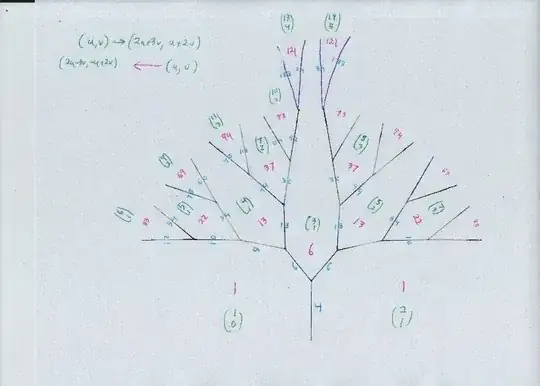EDIT: There are infinitely many integer solutions. They can all be found. In particular, if you have one solution $(a,b)$ you get a new solution with
$$ (a,b) \mapsto (-b, a + 4 b). $$ Going in the reverse direction,
$$ (a,b) \mapsto ( 4a + b, -a). $$ For solutions to $a^2 + 4ab + b^2 = 121,$ we will almost always need $ab < 0.$
Um. The generator for the (oriented) integer automorphism group of the quadratic form $a^2 + 4ab + b^2$ is
$$
A =
\left(
\begin{array}{rr}
0 & -1 \\
1 & 4
\end{array}
\right),
$$
with inverse
$$
A^{-1} =
\left(
\begin{array}{rr}
4 & 1 \\
-1 & 0
\end{array}
\right).
$$
The degree two linear recurrences that follow come from applying Cayley-Hamilton to $A,$ in that $A^2 - 4A + I = 0.$
In the original variables, we can collect all solutions into Fibonacci type sequences, as in $a_{n+2} = 4 a_{n+1} - a_n$ and $b_{n+2} = 4 b_{n+1} - b_n$
$$
\begin{array}{rrrrrrrrrrr}
-4736 & -1269 & -340 & -91 & -24 & -5 & 4 & 21 & 80 & 299 & 1116 \\
1269 & 340 & 91 & 24 & 5 & -4 & -21 & -80 & -299 & -1116 & -4165
\end{array}
$$
We can do the same thing for the solutions where both $(a,b)$ are divisible by $11.$ Oh, not only can we switch the variables, we can always negate both. So $(-5,-4)$ gives us $(5,4)$ and $(4,5).$
$$
\begin{array}{rrrrrrrrrr}
-616 & -165 & -44 & -11 & 0 & 11 & 44 & 165 & 616 & 2299 \\
2299 & 616 & 165 & 44 & 11 & 0 & -11 & -44 & -165 & -616
\end{array}
$$
ORIGINAL: take the invertible change of variables
$$ a = u - 2 v, \;\; \; b = v,$$ so that $a + 2 b = u.$ You have
$$ u^2 - 3 v^2 = 121. $$
There are the imprimitive solutions where $u,v$ are solutions of $u^2 - 3 v^2 = 1$ then multiply both by $11.$
There are infinitely many of these, this is called the Pell equation.
There are also infinitely many imprimitive solutions to $u^2 - 3 v^2 = 121.$ This begins with $1 - 3 \cdot 4 = -11,$ and Brahmagupta's formula leads to $13^2 - 3 \cdot 4^2 = 11^2.$
In both cases, given values $(u,v),$ changing to $(2u+3v, u + 2 v)$ gives the same value of $u^2 - 3 v^2.$ You should check that, important.
A full accounting of all $(u,v)$ pairs is given by combining the $(2u+3v, u + 2 v)$ formula with the Conway topograph.
Here are some answers with the topograph , then two books that talk about it:
Another quadratic Diophantine equation: How do I proceed?
How to find solutions of $x^2-3y^2=-2$?
Generate solutions of Quadratic Diophantine Equation
Finding all solutions of the Pell-type equation $x^2-5y^2 = -4$
how to solve binary form $ax^2+bxy+cy^2=m$, for integer and rational $ (x,y)$
Find all integer solutions for the equation $|5x^2 - y^2| = 4$
Maps of primitive vectors and Conway's river, has anyone built this in SAGE?
Infinitely many systems of $23$ consecutive integers
Finding integers of the form $3x^2 + xy - 5y^2$ where $x$ and $y$ are integers, using diagram via arithmetic progression
Small integral representation as $x^2-2y^2$ in Pell's equation
Solving the equation $ x^2-7y^2=-3 $ over integers
Solutions to Diophantine Equations
http://www.maa.org/press/maa-reviews/the-sensual-quadratic-form (Conway)
http://www.springer.com/us/book/9780387955872 (Stillwell)
I'm afraid I was not able to fit this entire diagram onto one page. However, combine this with How to find solutions of $x^2-3y^2=-2$?
and you get all integer expressions for $u^2 - 3 v^2 = 121,$ which then lead to all $a^2 + 4ab + b^2 = 121.$

All solutions $(u,v)$ come from the transformation $(2u+3v, u + 2 v),$ its inverse $(2u-3v, -u + 2 v),$ and the three triples
$$ (11,0), (13,4),(14,5) $$
Some care is need for the original $(a,b)$ problem because the change of variables does not quite keep positivity. Indeed, instead of the $\pm$ symmetries, the original variables have $(a,b)$ going to $(b,a).$
